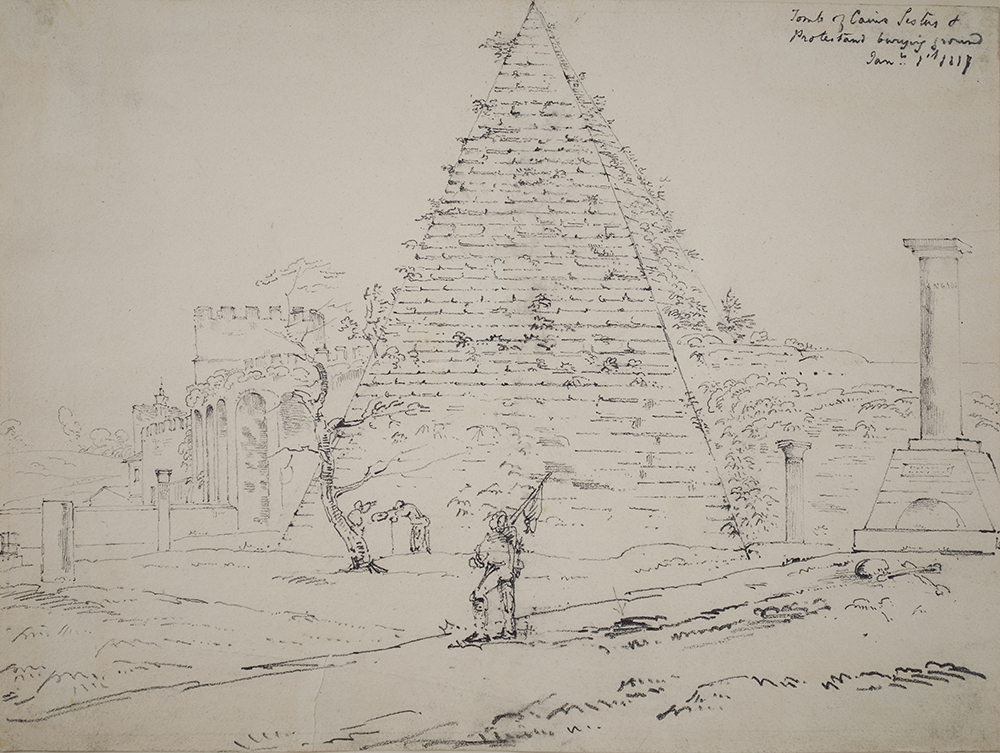
Tomb of Caius Cestius at Protestant Burying Ground
The charcoal drawing Tomb of Caius Cestius at Protestant Burying Ground (1817) was donated to the Samuel Dorsky Museum of Art by Dr. and Mrs. Frederick Elias and is attributed to the British painter and draughtsman, Joseph Mallord William Turner. This work is not signed but can most likely be accredited to Turner on the basis of its style and subject matter.
The tomb of Caius Cestius is located near a Protestant burial ground in Rome, Italy. This marble covered pyramid, built about 18 to 12 BCE, was made for Caius Cestius who was a magistrate and member of the college of Septemviri Epulonum, a group of ancient Roman priests who conducted sacrificial banquets to their gods. In the eighteenth and nineteenth centuries CE, Rome was entirely under the control of the Vatican and the city was considered sacred ground; non-Catholics were not allowed to be buried there. However, due to the wave of Protestants that entered the city as a part of the Grand Tour, arrangements were made for the development of a Protestant cemetery.
Turner, best known for his representations of sublime landscapes, was an artist of the Romantic period which lasted from about 1750 until 1850 and was characterized by imaginative and emotional imagery as well as an increased interest in antiquity and the medieval. Turner, like many other Romantic artists of his time, had a great interest in the classical ruins of Italy. Around 1817, Turner was commissioned to make watercolors of famous sites for James Hakewill’s book, A Picturesque Tour of Italy: From Drawings Made in 1816-1817, which included an engraving of a watercolor of the tomb of Caius Cestius made by Turner from a Hakewill drawing. Turner did not actually travel to Italy until 1819 (after the end of the French wars of 1792-1815).
The tomb is situated at the center of the composition; the sharp diagonals of the pyramid’s edges cut through space to form a point at the top edge of the paper. It is clearly depicted as a relic of antiquity; wild vegetation sprouts from almost every crevice between the marble bricks. A wall to the right of the tomb is entirely overcome with billowing bushes and vines. A small, Doric column stands directly in front of the wall. Nearby, a second column sits on top of a trapezoidal plinth with a skull and crossbones at its base. These objects might be a reference to the Protestant cemetery nearby or perhaps a romantic inclination towards macabre subject matter. To the left of the tomb, the turrets of the San Paolo Gate of the Aurelian Walls, dated to the 3rd century CE, are seen receding into the background. Beneath the towering structure of the tomb, two figures interact with each other. One supports himself with a cane while the other gesticulates as if in conversation. These figures, as well as the spindly tree that is planted beside them, allow the viewer to comprehend the massive scale of the tomb. In the foreground, a third figure boldly poses with his back to the viewer. He appears to be dressed in the armor of a knight with a flag over his shoulder. The inclusion of this figure corresponds with the idealization of the medieval seen in the Romantic era.
— Teresa Ferguson, Class of ‘20, Online Collections Management Intern

